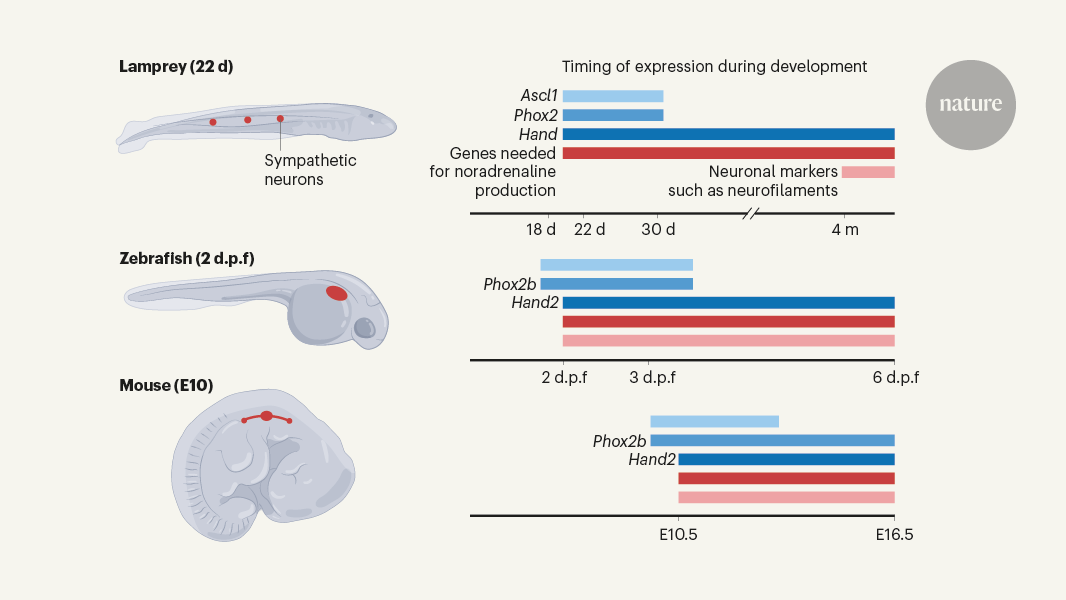spostrzeżenie - Computational Biology - # Evolutionary Development of the Sympathetic Nervous System
The Evolutionary Origins of the Sympathetic Nervous System in Vertebrates
Główne pojęcia
The sympathetic nervous system, associated with the fight-or-flight response, arose in the earliest vertebrates and is not limited to jawed vertebrates.
Streszczenie
The article discusses the evolutionary origins of the sympathetic nervous system, a key innovation in the development of vertebrates. The sympathetic nervous system is associated with the fight-or-flight response and the neurotransmitters adrenaline and noradrenaline.
The author highlights that the sympathetic nervous system is not found solely in jawed vertebrates, but that the basic building blocks and developmental regulators of this system are also present in the jawless vertebrate fish, the sea lamprey (Petromyzon marinus). This suggests that the sympathetic nervous system arose in the earliest vertebrates, rather than being a more recent development.
The article provides insights into the evolutionary history and development of the sympathetic nervous system, a crucial component of the vertebrate nervous system that plays a vital role in the body's response to stress and other environmental challenges.
The sympathetic nervous system arose in the earliest vertebrates
Statystyki
The sympathetic nervous system is associated with the fight-or-flight response and the neurotransmitters adrenaline and noradrenaline.
The basic building blocks and developmental regulators of the sympathetic nervous system are present in the jawless vertebrate fish, the sea lamprey (Petromyzon marinus).
Cytaty
"One of the key innovations that arose in vertebrates was the evolution of a branch of the nervous system called the sympathetic nervous system."
"The sympathetic nervous system is associated with the fight-or-flight response and the neurotransmitter signalling molecules adrenaline and noradrenaline."
"The sympathetic nervous system is not found solely in jawed vertebrates, and that the basic building blocks and developmental regulators of a sympathetic nervous system are also present in the jawless vertebrate fish the sea lamprey (Petromyzon marinus)."
Kluczowe wnioski z
by Uwe Ernsberg... o www.nature.com 04-17-2024
https://www.nature.com/articles/d41586-024-01017-4
Głębsze pytania
How did the evolution of the sympathetic nervous system contribute to the overall development and adaptability of vertebrates?
The evolution of the sympathetic nervous system played a crucial role in the overall development and adaptability of vertebrates. This system is associated with the fight-or-flight response, which is essential for survival in challenging or threatening situations. By triggering the release of adrenaline and noradrenaline, the sympathetic nervous system prepares the body to respond quickly to danger, increasing heart rate, dilating airways, and redirecting blood flow to vital organs. This physiological response enhances the chances of survival in vertebrates facing predators or other threats. Additionally, the sympathetic nervous system helps regulate various bodily functions, such as blood pressure, metabolism, and temperature, contributing to the overall homeostasis and well-being of vertebrates.
What other key innovations in the nervous system may have arisen in the earliest vertebrates, and how did they shape the subsequent evolution of this lineage?
In addition to the sympathetic nervous system, other key innovations in the nervous system may have arisen in the earliest vertebrates. One such innovation is the development of the central nervous system, including the brain and spinal cord, which allowed for more complex sensory processing and motor coordination. The evolution of sensory organs, such as eyes and ears, also played a crucial role in detecting environmental cues and responding to them effectively. Furthermore, the emergence of myelinated nerve fibers enabled faster and more efficient transmission of nerve impulses, enhancing the speed and coordination of vertebrate movements. These innovations in the nervous system shaped the subsequent evolution of vertebrates by increasing their ability to perceive and interact with their surroundings, ultimately leading to the diversification and success of this lineage.
What insights can the study of the sympathetic nervous system in jawless vertebrates, such as the sea lamprey, provide into the broader evolutionary history and development of the vertebrate nervous system?
Studying the sympathetic nervous system in jawless vertebrates, like the sea lamprey, can provide valuable insights into the broader evolutionary history and development of the vertebrate nervous system. The presence of basic building blocks and developmental regulators of the sympathetic nervous system in sea lampreys suggests that this system has ancient origins, dating back to early vertebrates. By comparing the structure and function of the sympathetic nervous system in jawless vertebrates with that of jawed vertebrates, researchers can gain a better understanding of the evolutionary changes that occurred in this system over time. Additionally, studying the sympathetic nervous system in diverse vertebrate species can help elucidate the genetic and molecular mechanisms underlying its development and regulation, shedding light on the evolutionary processes that have shaped the vertebrate nervous system throughout history.
0
